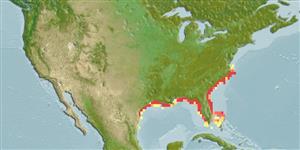>
Blenniiformes (Blennies) >
Blenniidae (Combtooth blennies) > Salariinae
Etymology: Hypleurochilus: Greek, hypo = under + Greek, pleura = in the side of + Greek, cheilos = lip.
Environment: milieu / climate zone / depth range / distribution range
экология
морской ассоциированный с рифами. Subtropical; 37°N - 24°N, 98°W - 74°W
Western Atlantic: North Carolina to Texas, including southern Florida in the USA. Recorded from coast of Central and South America (to Brazil), but these records probably are not of this species.
Size / Вес / Возраст
Maturity: Lm ? range ? - ? cm
Max length : 10.0 cm TL самец/пол неопределен; (Ref. 7251)
колючие лучи спинного плавника (общее число) : 12; колючие лучи анального плавника: 2; членистые (мягкие) лучи анального плавника: 17. Species distinguished by: preopercular sensory pore series with 1 pore (sometimes 2) at each position (New Jersey to northeastern Florida); dorsal fin not separated into 2 portions by deep notch; dorsal-fin spines usually 12, the last easy to see; total dorsal-fin elements 25 to 30; caudal fin uniformly pigmented or mottled with dark spots; segmented caudal-fin soft rays usually 13; segmented anal-fin rays usually 17; pelvic fins with 1 spine and 4 soft rays; pectoral-fin soft rays usually 13 or 14; an enlarged canine tooth present posteriorly on both sides of 1 or both jaws (sometimes absent on 1 side); no teeth on vomer; gill openings not continuous, each restricted to side of head, extending ventrally to about midlevel of pectoral-fin base or further (may extend completely around lower side of head and form common opening with gill opening of opposite side); cirri present only on eyes; ventral edge of upper lip smooth; lateral line never consisting of 2 disconnected, overlapping portions. Common amongst Blenniids: small, slender fishes, largest species to about 13 cm SL, most under 7.5 cm SL. Eyes high on sides of head; mouth ventral, upper jaw not protractile. A single row of incisor-like teeth in each jaw and often an enlarged canine-like tooth posteriorly on each side of lower jaw and sometimes upper jaw; no teeth on palatines. Dorsal and anal fins long, their spines usually flexible; dorsal fin with fewer spines than segmented (soft) rays; 2 spines in anal fin, scarcely differentiated from the segmented rays, the first not visible in females, both often supporting fleshy, bulbous, rugose swellings at their tips in males; pelvic fins inserted anterior to base of pectoral fins, with 1 spine (not visible) and segmented rays; all segmented fin rays, except those of caudal fin, unbranched (simple), caudal-fin rays of adults branched. All species lack scales (Ref.52855).
Oviparous. Eggs are demersal and adhesive (Ref. 205), and are attached to the substrate via a filamentous, adhesive pad or pedestal (Ref. 94114). Larvae are planktonic, often found in shallow, coastal waters (Ref. 94114).
Life cycle and mating behavior
Maturities | размножение | Spawnings | Egg(s) | Fecundities | личинки
Oviparous, distinct pairing (Ref. 205).
Robins, C.R. and G.C. Ray, 1986. A field guide to Atlantic coast fishes of North America. Houghton Mifflin Company, Boston, U.S.A. 354 p. (Ref. 7251)
Статус Красного Списка МСОП (Ref. 130435)
Угроза для людей
Harmless
Использование человеком
рыболовство: интереса не представляет
дополнительная информация
инструменты
Специальные отчеты
Скачать в формате XML
ресурсы в Интернет
Estimates based on models
Preferred temperature (Ref.
123201): 23.2 - 26.1, mean 24 °C (based on 136 cells).
Phylogenetic diversity index (Ref.
82804): PD
50 = 0.5005 [Uniqueness, from 0.5 = low to 2.0 = high].
Bayesian length-weight: a=0.00741 (0.00335 - 0.01640), b=3.02 (2.83 - 3.21), in cm total length, based on LWR estimates for this (Sub)family-body shape (Ref.
93245).
Trophic level (Ref.
69278): 3.2 ±0.3 se; based on size and trophs of closest relatives
устойчивость к внешним воздействиям (Ref.
120179): высокий, минимальное время удвоения популяции до 15 месяцев (Preliminary K or Fecundity.).
Fishing Vulnerability (Ref.
59153): Low vulnerability (10 of 100).
Nutrients (Ref.
124155): Calcium = 94.3 [35.8, 179.7] mg/100g; Iron = 0.803 [0.427, 1.498] mg/100g; Protein = 18.9 [17.7, 20.0] %; Omega3 = 0.145 [0.073, 0.273] g/100g; Selenium = 11.4 [4.8, 26.9] μg/100g; VitaminA = 78.7 [21.0, 293.6] μg/100g; Zinc = 1.46 [0.87, 2.30] mg/100g (wet weight);
